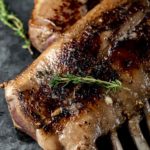Sous Vide Rack of Lamb
Tender and juicy Sous Vide Rack of Lamb is easy to prepare with a simple seasoning and only takes 2 hours to cook using your sous vide!
Servings: 8 people
Calories: 353kcal
Ingredients
- 2-3 pounds rack(s) of lamb
- 2 teaspoons salt
- ½ teaspoon black pepper
- 2 garlic cloves smashed
- 2 sprigs fresh thyme
- 1 teaspoon honey
- 1 tablespoon sherry vinegar
- 1 tablespoon grainy dijon mustard
- 3 tablespoons butter
- ¼ cup beef stock
Instructions
- Heat a sous vide water bath to 130F degrees.
- Add all the ingredients, except the butter and beef stock, in a bowl and mix together.
- Rub the mixture all over the lamb and place in a freezer safe bag (for water displacement method) or vacuum sealable bag. Seal the bag. (Be careful using the vacuum sealer as the bones may puncture holes in the bag when sealing).
- Cook in the water bath for 2 hours and then remove.
- Open the bag and remove the lamb, reserving the bag juice in a small saucepan.
- Add the beef stock to the bag juice and simmer for 3-5 minutes, skimming any impurities off the top. Adjust salt to taste and set aside.
- Heat a skillet on medium-high heat and add the butter.
- Add the lamb and brown on each side, basting with butter until golden brown all around, about 2 minutes total.
- Remove and let cool slightly. Slice and serve drizzled with the jus.
Notes
- Whether you use a vacuum seal or ziplock bag, you’ll want to make sure to remove the air from the bag to avoid bacteria getting in.
- If the bag starts to fill with air and float during the cooking process, you can open the bag, remove the air and reseal it.
- To help prevent floating, I like to use a sous vide sinker weight.
- Be sure to use a large enough bag to fit the racks of lamb. If using a vacuum seal bag, be careful that the bones don’t pierce the bag as it’s sealed.
- To get the best sear, pat the lamb rack dry with paper towels after it comes out of the water bath.
- When heating the butter for searing, you’ll want to use medium-high heat. The skillet should be hot for a good sear, but if it’s too hot, the butter may burn up.
- Sear the lamb for just 1 minute per side. Any longer and you risk overcooking and drying out the lamb.
- Make sure you baste the lamb as you sear it. This adds flavor and helps create a delicious crust.
- Depending on the size of your lamb racks and your skillet, you may need to sear the lamb in two batches.
- You can also broil the lamb to achieve a crust, but I find basting is easier when the lamb is seared on the stovetop.
Nutrition
Serving: 4ounces | Calories: 353kcal | Carbohydrates: 1g | Protein: 12g | Fat: 33g | Saturated Fat: 15g | Polyunsaturated Fat: 2g | Monounsaturated Fat: 13g | Trans Fat: 1g | Cholesterol: 74mg | Sodium: 702mg | Potassium: 183mg | Fiber: 1g | Sugar: 1g | Vitamin A: 145IU | Vitamin C: 1mg | Calcium: 19mg | Iron: 1mg
